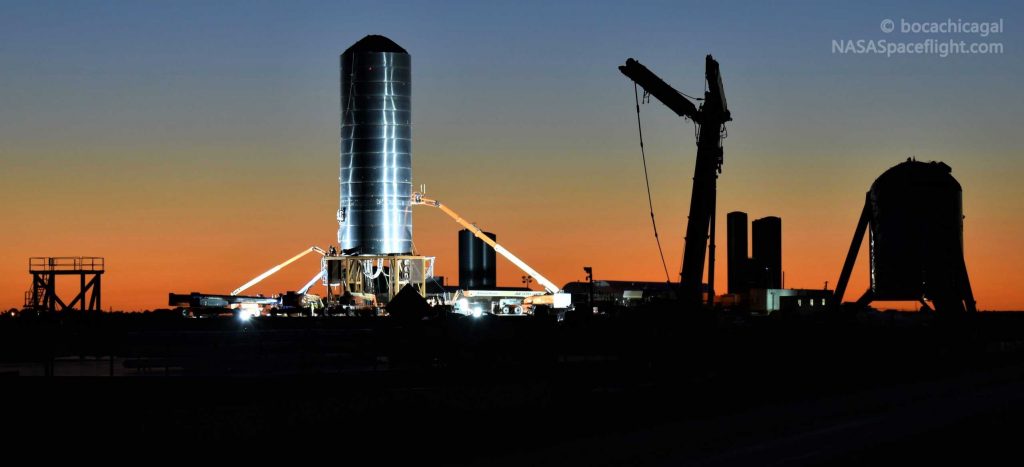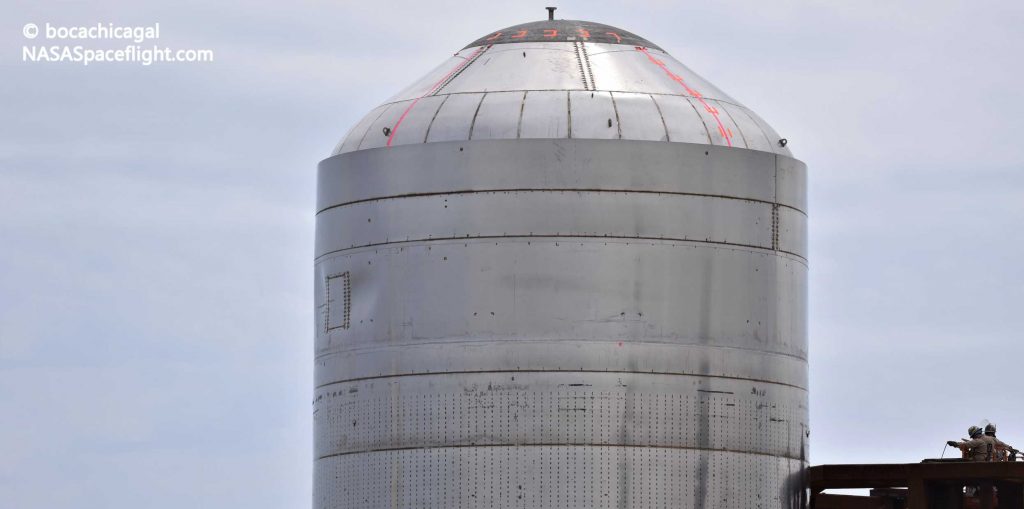

News
SpaceX's latest Starship test was uneventful and that's great news for its flight debut
According to Elon Musk, SpaceX has successfully completed its latest Starship prototype test in a uniquely uneventful fashion, great news for the next-generation rocket’s next steps and first flight tests.
The SpaceX CEO revealed the news some 12 hours after the company wrapped up the Starship tank test at its Boca Chica, Texas facilities. Another excellent example of SpaceX’s preferred process of agile development, the test followed just nine days after the Starship SN01 prototype’s first cryogenic test unexpectedly unearthed a design flaw. SpaceX analyzed the results of Starship SN01’s unintentional launch debut and drew up plans to rapidly repurpose a Starship tank initially destined for the SN02 prototype.
By using existing hardware to test an upgraded iteration of the part that destroyed Starship SN01, SpaceX has now effectively retired the risk posed by that prior failure less than two weeks after it occurred. Elon Musk specifically noted that the former SN02 engine section “passed cryo pressure & engine thrust loads,” confirming that there was more to the exceptionally uneventful evening of March 8th than met the eye. While putting on much less of a show for local observers, this particular boring test is a great sign for the next few steps of SpaceX’s Starship development program.
SN2 (with thrust puck) passed cryo pressure & engine thrust load tests late last night— Elon Musk (@elonmusk) March 9, 2020

Simply put, despite successfully demonstrating that Starship’s improved “thrust puck” and engine section can survive flight-level tank pressures and the thrust of a Raptor engine, one would be hard-pressed to determine as much by inspecting the prototype that managed the feat. Such a visually uneventful test is a first for SpaceX’s post-Starhopper Starship testing, where “before” and “after” photos typically start with a shiny tank and finish with a well-distributed field of steel shrapnel.



Musk’s description of the test suggests that SpaceX’s intention with the SN02 test tank – built in just two weeks – was to stress it up to (and likely beyond) the pressures and mechanical stresses Starship engine sections will need to survive in flight. In simpler terms, they likely tried to burst the tank by pressurizing it with liquid nitrogen, a supercool cryogenic fluid. It’s unclear exactly how far SpaceX pushed the tank, but it’s safe to say that it went at least as high as past test tanks, meaning 7-8.5 bar or 100-125 psi. At a bare minimum, a test that failed to reach Starship’s minimum flight pressure of 6 bar (90 psi) would be of dubious value for the actual orbital ship.
A step further, SpaceX installed a hydraulic jack underneath the test tank in a bid to simulate the stresses it would experience with a single Raptor engine. Capable of producing approximately 150-200 tons (1500-2000 kN) of thrust, even Raptor is relatively minor compared to the Starship tank’s likely ~500 metric ton (1.1 million lb) mass. Still, the fact that the SN02 test tank survived the combination of a highly pressurized tank and the simulated thrust of a Raptor engine suggests that SpaceX is now ready for a more successful repeat of Starship SN01 testing.
Confirming those suspicions, Musk subsequently revealed that the Starship prototype integrated immediately after the SN02 test tank will likely attempt the first Raptor static fire tests and may even perform short flights further down the road. As always, SpaceX’s testing programs are fluid and likely to change as new results continuously shape the path forward, meaning that Starship SN03 could easily be destroyed during testing. Starship SN04, said by Musk to be the hopeful candidate for “longer [test] flights,” would thus be repurposed to continue SN03’s test campaign — and so on with SN05, SN06, and beyond.
Regardless, as the CEO notes, perhaps the most important aspect of all these rapid-fire tests is that SpaceX is quickly building up an impressive Starship production line. Before, during, and after SN02’s test campaign, SpaceX’s South Texas team has been simultaneously fabricating and stacking new steel rings, bulkheads, and noses for the next few Starship prototypes. As a result, Starship SN03’s tank section could be just a week or two away from complete integration, after which SpaceX will likely transport it to the launch pad to prepare for Raptor static fire testing.
Check out Teslarati’s Marketplace! We offer Tesla accessories, including for the Tesla Cybertruck and Tesla Model 3.
News
Tesla begins Robotaxi certification push in Arizona: report
Tesla seems serious about expanding its Robotaxi service to several states in the coming months.

Tesla has initiated discussions with Arizona transportation regulators to certify its driverless Robotaxi service in the state, as per a recent report from Bloomberg News. The move follows Tesla’s launch of its Robotaxi pilot program in Austin, Texas, as well as CEO Elon Musk’s recent comments about the service’s expansion in the Bay Area.
The Arizona Department of Transportation confirmed to Bloomberg that Tesla has reached out to begin the certification process for autonomous ride-sharing operations in the state. While details remain limited, the outreach suggests that Tesla is serious about expanding its driverless Robotaxi service to several territories in the coming months.
The Arizona development comes as Tesla prepares to expand its service area in Austin this weekend, as per CEO Elon Musk in a post on X. Musk also stated that Tesla is targeting the San Francisco Bay Area as its next major market, with a potential launch “in a month or two,” pending regulatory approvals.
Tesla first launched its autonomous ride-hailing program on June 22 in Austin with a small fleet of Model Y vehicles, accompanied by a Tesla employee in the passenger seat to monitor safety. While still classified as a test, Musk has said the program will expand to about 1,000 vehicles in the coming months. Tesla will later upgrade its Robotaxi fleet with the Cyercab, a two-seater that is designed without a steering wheel.
Sightings of Cybercab castings around the Giga Texas complex suggests that Tesla may be ramping the initial trial production of the self-driving two-seater. Tesla, for its part, has noted in the past that volume production of the Cybercab is expected to start sometime next year.
In California, Tesla has already applied for a transportation charter-party carrier permit from the state’s Public Utilities Commission. The company is reportedly taking a phased approach to operating in California, with the Robotaxi service starting with pre-arranged rides for employees in vehicles with safety drivers.
News
Tesla sets November 6 date for 2025 Annual Shareholder Meeting
The automaker announced the date on Thursday in a Form 8-K.

Tesla has scheduled its 2025 annual shareholder meeting for November 6, addressing investor concerns that the company was nearing a legal deadline to hold the event.
The automaker announced the date on Thursday in a Form 8-K submitted to the United States Securities and Exchange Commission (SEC). The company also listed a new proposal submission deadline of July 31 for items to be included in the proxy statement.
Tesla’s announcement followed calls from a group of 27 shareholders, including the leaders of large public pension funds, which urged Tesla’s board to formally set the meeting date, as noted in a report from The Wall Street Journal.
The group noted that under Texas law, where Tesla is now incorporated, companies must hold annual meetings within 13 months of the last one if requested by shareholders. Tesla’s previous annual shareholder meeting was held on June 13, 2024, which placed the July 13 deadline in focus.
Tesla originally stated in its 2024 annual report that it would file its proxy statement by the end of April. However, an amended filing on April 30 indicated that the Board of Directors had not yet finalized a meeting date, at least at the time.
The April filing also confirmed that Tesla’s board had formed a special committee to evaluate certain matters related to CEO Elon Musk’s compensation plan. Musk’s CEO performance award remains at the center of a lengthy legal dispute in Delaware, Tesla’s former state of incorporation.
Due to the aftermath of Musk’s legal dispute about his compensation plan in Delaware, he has not been paid for his work at Tesla for several years. Musk, for his part, has noted that he is more concerned about his voting stake in Tesla than his actual salary.
At last year’s annual meeting, TSLA shareholders voted to reapprove Elon Musk’s compensation plan and ratified Tesla’s decision to relocate its legal domicile from Delaware to Texas.
Elon Musk
Grok coming to Tesla vehicles next week “at the latest:” Elon Musk
Grok’s rollout to Tesla vehicles is expected to begin next week at the latest.

Elon Musk announced on Thursday that Grok, the large language model developed by his startup xAI, will soon be available in Tesla vehicles. Grok’s rollout to Tesla vehicles is expected to begin next week at the latest, further deepening the ties between the two Elon Musk-led companies.
Tesla–xAI synergy
Musk confirmed the news on X shortly after livestreaming the release of Grok 4, xAI’s latest large language model. “Grok is coming to Tesla vehicles very soon. Next week at the latest,” Musk wrote in a post on social media platform X.
During the livestream, Musk and several members of the xAI team highlighted several upgrades to Grok 4’s voice capabilities and performance metrics, positioning the LLM as competitive with top-tier models from OpenAI and Google.
The in-vehicle integration of Grok marks a new chapter in Tesla’s AI development. While Tesla has long relied on in-house systems for autonomous driving and energy optimization, Grok’s integration would introduce conversational AI directly into its vehicles’ user experience. This integration could potentially improve customer interaction inside Tesla vehicles.
xAI and Tesla’s collaborative footprint
Grok’s upcoming rollout to Tesla vehicles adds to a growing business relationship between Tesla and xAI. Earlier this year, Tesla disclosed that it generated $198.3 million in revenue from commercial, consulting, and support agreements with xAI, as noted in a report from Bloomberg News. A large portion of that amount, however, came from the sale of Megapack energy storage systems to the artificial intelligence startup.
In July 2023, Musk polled X users about whether Tesla should invest $5 billion in xAI. While no formal investment has been made so far, 68% of poll participants voted yes, and Musk has since stated that the idea would be discussed with Tesla’s board.
-

 Elon Musk1 week ago
Elon Musk1 week agoTesla investors will be shocked by Jim Cramer’s latest assessment
-

 Elon Musk3 days ago
Elon Musk3 days agoElon Musk confirms Grok 4 launch on July 9 with livestream event
-

 Elon Musk14 hours ago
Elon Musk14 hours agoxAI launches Grok 4 with new $300/month SuperGrok Heavy subscription
-

 News7 days ago
News7 days agoTesla Model 3 ranks as the safest new car in Europe for 2025, per Euro NCAP tests
-

 Elon Musk2 weeks ago
Elon Musk2 weeks agoA Tesla just delivered itself to a customer autonomously, Elon Musk confirms
-

 Elon Musk1 week ago
Elon Musk1 week agoxAI’s Memphis data center receives air permit despite community criticism
-

 Elon Musk2 weeks ago
Elon Musk2 weeks agoTesla’s Omead Afshar, known as Elon Musk’s right-hand man, leaves company: reports
-

 News2 weeks ago
News2 weeks agoXiaomi CEO congratulates Tesla on first FSD delivery: “We have to continue learning!”













